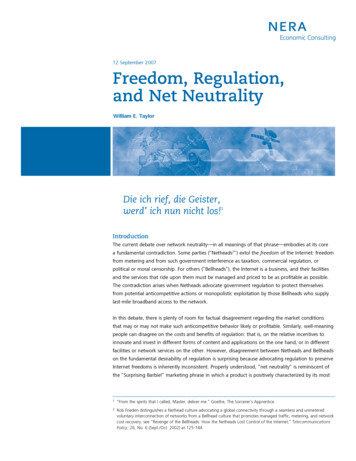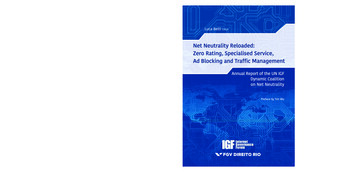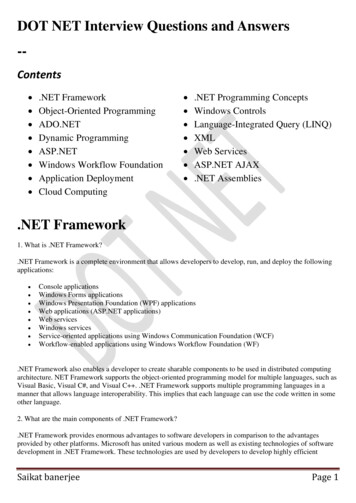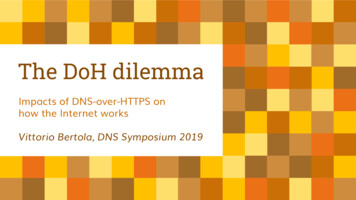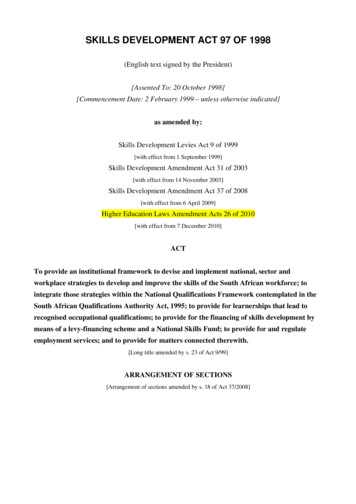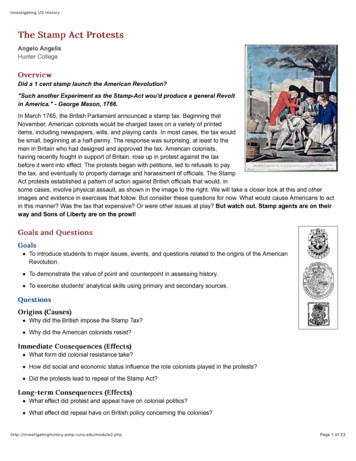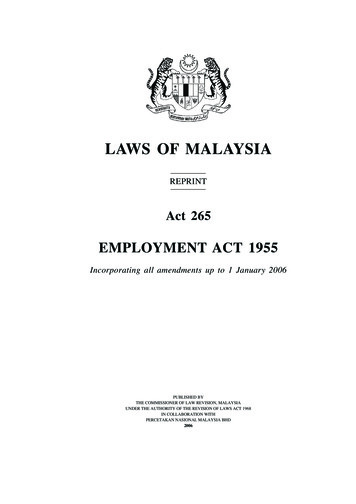
Transcription
International Journal of Business and Social ScienceVol. 10 No. 1 January 2019doi:10.30845/ijbss.v10n1p1Net Neutrality Repeal and its Effect on ConsumersHéctor R. LozadaAssociate Professor of MarketingStillman School of BusinessSeton Hall UniversityUSAGary H. KritzAssociate Professor of MarketingStillman School of BusinessSeton Hall UniversityUSAAbstractNet neutrality is the principle that Internet Service Providers, (ISPs), and governments should treat all data onthe Internet the same, not discriminating or charging differentially by user, content, site, platform,application, type of attached equipment, or mode of communication. In early 2015, the Federal CommunicationsCommittee (FCC) adopted rules to keep the Internet net neutral denying preferential treatment for ContentProviders (CPs) that are more data-rich than other CPs. By late 2017, the new chair of the FCC announced thatthe agency would end the net neutrality rules adopted during the Obama administration. In this paper, we explorewhere net neutrality rules stand, and look at both sides of the net neutrality argument. We close by discussinganswers to the questions surrounding the potential effects an Internet without net neutrality could have onconsumers.Keywords: Internet, net neutrality, online content consumers, access regulations1.0 IntroductionIn December of 2017, the Chairman of the Federal Communications Commission (FCC), Ajit Pai, announced theCommission's decision to end the concept of “net neutrality.” The commission would do so through itsdismantling of regulations put in place in 2015 by the FCC itself under the Obama Administration. According toKang (2017), these regulations were established to ensure stronger government oversight of Internet ServiceProviders (ISPs) and their business practices.The demise of net neutrality caused an initial stir from the general public, congressional leaders, and stategovernments. Multiple lawsuits and a congressional petition were filed, or are anticipated to be filed, to block orreverse the decision to end net neutrality regulations. Assuming that the repeal of net neutrality survives all thecourt challenges, and the challenges from congressional lawmakers, what would the economic impact of a nonneutral internet look like for consumers? Will consumers experience slower internet service on certain websites,because companies cannot afford to pay a premium price to have faster Internet speeds? Alternatively, would itresult in more network options and services for consumers, as Mr. Pai and the ISP’s have claimed?This article provides background context of net neutrality laws and the conditions on which they were rolled back.We then explore both sides of the net neutrality argument. We close by providing a path to answer the questionregarding the effects an Internet without net neutrality could have on consumers.2.0 Background and TimelineIn 2005, the United States Federal Communications Commission established the concept of an “open internet”with four major principles that would “encourage broadband deployment, and preserve and promote the open andinterconnected nature of the public Internet.” These principles were as follows (FCC 2005): Consumers are entitled to access the lawful Internet content of their choice.1
ISSN 2219-1933 (Print), 2219-6021 (Online) Center for Promoting Ideas, USAwww.ijbssnet.com Consumers are entitled to run applications and use services of their choice, subject to the needs of lawenforcement. Consumers are entitled to connect their choice of legal devices that do not harm the network. Consumers are entitled to competition among network providers, application and service providers, andcontent providers.These tenets for net neutrality existed as general guidelines when the FCC wrote them into law with the passingof the Open Internet Order in 2010. At that time, FCC Commissioner Julius Genachowski added to these generalprinciples the idea that ISPs may not discriminate against content in any way (Anderson 2009). The 2010 Orderwas met with plenty of opposition from ISPs leading to a challenge from Verizon Wireless in the United StatesCourt of Appeals in 2014. Verizon won that case, resulting in the Court striking down the no blocking and nounreasonable discrimination aspects of the 2010 Order. According to the Court, the FCC had not distinguishedbroadband service providers as telecommunication services, and therefore, these companies were exempt frombeing treated as common carriers subject to FCC jurisdiction (Crews 2014). In summary, while both Verizon andAT&T are telecommunication service providers, they also provide broadband services, and this earned them theexemption in the court ruling.In response to the Court’s decision, in February 2015 the FCC adopted new regulations reclassifying all ISPs ascommon carriers subject to regulations ensuring that all consumers were provided fair access to their services.The ISPs were banned from having paid prioritization deals, though they could set aside fast lanes for someexceptions (Yu and Snider 2015). Predictably, the ISPs did not care for the FCC rewriting their rules after theyhad just earned a major victory in Federal Court. The ISPs response was to increase their influence inWashington in terms of lobbying and campaign donations.During the 2016 election cycle, Comcast donated a total of 3.9 million to 360 house members and 52 senators.Comcast was also the 12th biggest spender on federal lobbying with 118 lobbyists on the payroll totaling 14,330,000 spent. In addition, AT&T was the ninth biggest spender on federal lobbying ( 16,370,000),spending a half million dollars more than lobbying powerhouse the Business Roundtable (West 2017). The ISPslobbying efforts, along with Republican victories in Congress and the White House, led to the December 2017announcement of net neutrality rollbacks by Mr. Pai, one of the commissioners who voted against the 2015 FCCregulations, and who had been appointed Chairman of a now three-to-two Republican controlled FCC byPresident Trump. The rollbacks were approved by the FCC in February 2018.In response to the FCC’s rollback, state governments have taken up the fight to keep net neutrality alive in theU.S. In April 2018, the state of Oregon passed and signed into law a measure that requires state agencies to dobusiness only with ISPs that do not block, slow traffic, or accept payment to prioritize some data. California hasproposed a similar bill to the one that was passed by its neighbor to the north, and several other states areconsidering laws preventing Internet service providers from blocking and throttling content on consumers’broadband connections.It is extremely likely however, that these laws will continue to be challenged in court by ISPs, who will argue thatthe new federal rules prevent states from passing their own laws regarding net neutrality. To complicate matters,attorney generals in 23 states and the District of Columbia filed suits against the FCC in May 2018 seeking toprevent the implementation of the rollbacks, calling it arbitrary, capricious, and an abuse of discretion (Snider2018).In late February 2018, Congressional Democrats introduced a resolution aimed at undoing the FCC's repealof the net neutrality rules (Hendel and Gold 2018). Despite all the turmoil, six months after it was approved, theFCC’s repeal of net neutrality rules took effect on June 11, 2018 (Collins 2018).According to Collins (2018), several consumer advocates worry that broadband providers may begin selling theInternet in bundles, not unlike cable television packages. Another major concern is whether pay-to-play deals—allowing the ISPs to impose unregulated rate charges for Internet “fast lanes” and greater data usage— would benormalized and, as a result, consumers’ Internet habits would suffer. Since the rules prohibiting paid prioritizationno longer exist, large Internet and media companies, as well as affluent households, could occupy the fast laneswhile everyone else could be left in the slow lane. Collins (2018) also points out that some small-business ownersare worried that industry giants could pay to get an edge and leave them on an unfair playing field.2
International Journal of Business and Social ScienceVol. 10 No. 1 January 2019doi:10.30845/ijbss.v10n1p13.0 Is A Non-Neutral Internet a Bad Thing?Upon the announcement of the FCC rollback of the 2015 Net Neutrality regulations, Commissioner MichaelO’Rielly, who voted for passing the net neutrality repeal, stated that the Internet has functioned without netneutrality rules far longer than with them. This decision will not break the Internet (Petri 2017). O’Rielly sidedwith the argument made by ISPs that net neutrality restrictions needed to be removed because they werestrangling the ISP’s ability to grow and innovate, as the Internet did for years prior to the 2015 restrictions (Petri2017).Steimle (2014) asserts that several of the industries with major problems (for example, health care, education,housing, and banking) have something in common: they are all highly regulated by the Federal government. Inhis view, the telecom industry provides a stark contrast: since this industry was deregulated, innovation has led togrowth.Proponents of Net Neutrality say the telecoms have too much power. I agree. Everyone seems to agree thatmonopolies are bad and competition is good, and just like you, I would like to see more competition. But ifmonopolies are bad, why should we trust the U.S. government, the largest, most powerful monopoly in theworld?.(sic) If the telecoms are forced to compete in a truly free market, Comcast and Time Warner won’texist 10 years from now. They’ll be replaced by options that give us better service at a lower price (Steimle2014).Steimle’s argument is that net neutrality deregulation will allow the emergence of other ISPs that will competewith the big telecom/ISP companies, and this will drive down the price of service for consumers. McMillan(2014) argues further that a neutral Internet has never really existed to begin with.Today, privileged companies—including Google, Facebook, and Netflix—already benefit from what areessentially internet fast lanes, and this has been the case for years. Such web giants—and others—now havedirect connections to big ISPs like Comcast and Verizon, and they run dedicated computer servers deep insidethese ISPs We shouldn't waste so much breath on the idea of keeping the network completely neutral. Itisn't neutral now (McMillan 2014).McMillan continues by diving straight into the first argument brought up by Steimle, stating that rather thanregulation, what the public needs are ways to increase competition among ISPs because that is what will preventthe big companies from gaining so much power that they can completely control the market for internetbandwidth (McMillan 2014).4.0 Is Net Neutrality Needed?FCC Commissioner Jessica Rosenworcel argued when she voted against the rollback that she was doing sobecause the rollback would allow ISPs to block websites, throttle services and censor online content, ensconcingthe right to discriminate. She asserted that this would rather make our broadband markets less competitive, andconsumers will have no recourse (Petri 2017). Several Internet providers have pledged in the months leading up tothe net neutrality repeal vote that they would not block or throttle sites, but should they be given the benefit of thedoubt on this matter? Goldman (2011) reports that Verizon, AT&T, and T-Mobile all blocked Google’s mobilepayment application “Google Wallet” because it competed with the mobile payment application that they haddeveloped, which at the time was ironically called Isis, but was rebranded in 2014 as Softcard to distance itselffrom the militant terrorist group (Lunden 2014).Another example of blocking and paid prioritization occurred in 2014 when Netflix reluctantly agreed to payComcast an exorbitant fee for Comcast to increase the speed of Netflix streams (Goldman 2014). Comcast claimsit did not intentionally slow down Netflix video streams and that the slow service was caused by the Netflix’shigh volume of subscribers, but soon after a deal was reached that allowed Netflix to connect its servers toComcast’s network near key distribution points Netflix’s streaming speeds soared. Netflix would then enter intosimilar deals with AT&T, Verizon, and Time Warner Cable (Goldman 2014). This leads back to the point thatbig Telecom companies might not be worthy of consumers’ trust, while also showing that paid prioritization maybe more common in the near future of a free market Internet.3
ISSN 2219-1933 (Print), 2219-6021 (Online) Center for Promoting Ideas, USAwww.ijbssnet.comWhat would a free market and open Internet actually look like for consumers? It would probably look similar tohow the country of Portugal operates its Internet services. Portugal has a system set up where mobile providersoffer packages that count data differently based on the apps you want to use (Feldman 2017). If a user wanted tostream videos from Netflix and Hulu without paying an exorbitant amount of data fees the user can purchase theiradditional 10/month streaming package. A person wanting to access social media sites like Facebook orInstagram would add on the social-network package fee (Feldman 2017). Essentially, the Internet could becomethe new satellite television, where instead of paying for access to specific channel packages, consumers wouldhave to pay for access to certain social media or video streaming websites.5.0 ConclusionFCC Chairman Ajit Pai along with Internet service providers have argued that these rollbacks are a good thing forthe economy and consumers because it loosens regulations. “It’s basic economics,” Mr. Pai said in a speech atthe Newseum in April. “The more heavily you regulate something, the less of it you’re likely to get,” (Collins2017, 2018). Do the FCC and the ISPs really believe the public feels that service providers want these regulationsrolled back because it will increase the choices for the consumers and therefore lead to more competition for theservice providers? Alternatively, is it more likely that ISPs expect to gain much more in terms of charging fees,blocking sites, and paid prioritization?Commissioner Pai has also long been a proponent of the idea that before the regulations went into effect in 2015,service providers had not engaged in any of the practices the rules prohibit.Did these fast lanes and slow lanes exist? No. It’s almost as if the special interests pushing Title II weren’ttrying to solve a real problem but instead were looking for an excuse to achieve their longstanding goal offorcing the internet under the federal government’s control (Collins 2017).As we discussed earlier, this was not necessarily the case as evidenced by Netflix paying for access to Comcast’snetwork. However, it would be the case if Netflix increases its fees to consumers to pay for it. We must alsopoint out that there is evidence that paid prioritization was prevalent for big tech companies prior to 2015 (seeMcMillan 2014).The future of net neutrality did not align itself as one of the hottest topics for politicians leading into the 2018midterm elections. Speaking about the issue after the Midterm elections, Finley (2018)asserts that despite multiplepolls suggesting broad support for net neutrality from both Republican and Democratic voters, it was not a majorfactor. Consequently, we are not sure how the new Congress will deal with net neutrality, if at all, or if it wouldbe a relevant issue in the 2020 election cycle. Finley (2018) reports that the broadband industry is currentlypaying lip service to some form of net neutrality legislation as a response to the lawsuits seeking to reinstate theObama-era rules. However, the new Democratic majority in the House of Representatives will not be in a positionto overturn the new FCC rule come January 2019.Note the following specific recommendations for streaming video provided by Netflix (2018): 3 Mbps should forstandard definition (SD) video, 5 Mbps for high definition (HD) video and 25 Mbps for ultra-high definition (4K)video (Netflix 2018). We can safely assume that Hulu and YouTube have similar requirements. Presently, severalwireless operators are already bundling some of these data-rich services for their customers. A visit to theT-Mobile website on November 15, 2018 shows an offer for Netflix standard plus unlimited streaming ofentertainment. This plan includes two simultaneous streams in HD, but there is an explicit indication that standardspeed is approximately 128 kbps. A second example is AT&T’s Unlimited Choice& More subscription, whichcosts 45 a month for a single line (after a 10 deduction for direct payment), offers over 30 channels live & ondemand TV and HBO (AT&T 2018). In the fine print, however, AT&T states that video may be limited tostandard definition, that the 15 GB Mobile Hotspot per line that is included in the plan may limit its speed to amaximum of 128Kbps (AT&T Unlimited Data Plans 2018).Big telecom companies appear to be promising not to slow down or block websites, but at the same time, they areexplicitly stating that under certain circumstances they will lower the speed of the video definition. Areconsumers noticing? Whether consumers would be content by being in the “slow lanes” for the services that theycurrently enjoy remains to be seen. We realize that consumers would have to compare the speed/length of time ittakes to transfer data on these services and websites to know if they would prefer to pay for “faster lanes” underthe conditions mentioned before.4
International Journal of Business and Social ScienceVol. 10 No. 1 January 2019doi:10.30845/ijbss.v10n1p1However, if ISPs start to charge premiums for faster speeds for the services and websites that they use, will theybe complacent? Our preliminary data tell us that most of those willing to pay a premium for these services andwebsites would not be willing to pay more than 30 per month depending on the services offered in the bundle. Inthe near future, our intention is not only to study if the new Congress returns to the Obama-era rules, but alsowhat ISPs may be preparing to do in case there is a return to the 2015 rules.6.0 ReferencesAnderson, Nate (2009).“FCC Chairman Wants Network Neutrality, Wired and Wireless.” arsTechnica.com. September ess/.AT&T.com ans.html?WT.srch 1&kid aud-488124601089:kwd366571850605&cid 1523412946&source ECPS0000000PSM00P&gclid rqSuyLELYvt5vkNjOugI4K1 bS8BoCN0cQAvD BwE&gcld rqSuyLELYvt5vkNjOugI4K1 bS8BoCN0cQAvD BwE.AT&T Unlimited Data Plans / mobileshare.html.Breland, A. (2018). Senate Dems to Force Vote on Net Neutrality.TheHill.com. April30.http://thehill.com/po licy/technology/3 lins, K.(2018). Net Neutrality Has Officially Been Repealed. Here’s How That Could Affect You.NYTimes.com. June11.https://www.nytimes.com/2018/06/11/ technology/net-neutrality-repeal.html.Collins, K.(2017). Why Net Neutrality was Repealed and How It Affects You.NYTimes.com. December et-neutrality-rules.html.Crews Jr, C. W.(2014). Court Rules against Net Neutrality in Verizon V. FCC.Forbes.com. January v-fcc/ #17aaf79f2ed8.Federal Communications Commission (FCC) (2005). Policy Statement. Federal Communications Commission.September23.https://apps.fcc.gov/edocs public/attachmatch/FCC-05-151A1.pdf.Feldman, B. (2017). Without Net Neutrality, What Happens to My Netflix? NYMag.com. November y, K. (2018). The Midterm Election Didn’t Salvage Net Neutrality.Wired. November 7.https://www. -neutrality/.Goldman, D.(2011). Verizon Blocks Google Wallet. CNN.com/Money. December 6,http://money.c nn.com/2 011/12/06/technology/verizon blocks google wallet/ index.htm.Goldman, D. (2014). Slow Comcast Speeds Were Costing Netflix Customers.CNN Tech. Web. 29 netflix-comcast/ index.html.Hendel, J. &Gold, A.(2018). Democrats Introduce Resolution to Reverse FCC Net Neutrality Repeal. Politico.com. February rats-fcc-reverse-net-neutrali ty - 426641.Kang, C. (2017). F.C.C. Repeals Net Neutrality.The New York Times.Web. December 14.https://www. Nytimes ote.html.Lunden, I. (2014). Isis Mobile Wallet Rebrands as Softcard to Distance from Militant Terror Group. Techcrunch. m-miltant-terror-group/.McMillan, R (2014). What Everyone Gets Wrong in the Debate Over Net Neutrality.” Wired Business. Web. 23 missing/Netflix (2018). Internet Connection Speed Recommendations. Netflix.com, https://help. netflix.com/en/node/306OpenSecrets.org. Net /net neutrality/Petri, A. (2017). Net Neutrality is Gone. Feel the Freedom Coursing Through Your Veins. Washington Post. Web. 14 freedom-coursing-through-yourveins/?noredirect on&utm term .563b5a9da685.Snider, M. (2018). Net-Neutrality is Over. Now California, Oregon Are Stepping In. USA Today.com. April tes-pursue-their-ownlaws/529337002/.Steimle, J. (2014). Am I the Only Techie Against Net Neutrality? Forbes.com.May 14. available fcce96f70d5.T-Mobile.com s rl 1082060&ds rl 1254232&ds rl 1260234&cmpid ADV PB ONETI440 43700017346358183&mx ch ADV PB& vsrefdom 431-6477513&mchxkw :42587499790,ad:203534040605,s:g&gclid CjwKCAiA8rnfBRB3EiwAhrhBGvdanYYiCEglWU WJEgvSMIAT-FCG1FkpHCiAcrn4VP18zxU00rIBoC7YUQA vD BwE&gclsrc aw.ds.West, G. (2017). Money flows into net neutrality debate ahead of FCC vote.OpenSecrets.org. December /.Yu, Roger& Snider, M. (2015). FCC Approves New Net Neutrality Rules.USA Today. February /fcc-approves- net-neutrality-rules/24053057/.The authors thank the Institute of International Business in the Stillman School of Business at Seton Hall University, South Orange, NewJersey, for their generous support of this research.5
Comcast was also the 12th biggest spender on federal lobbying with 118 lobbyists on the payroll totaling 14,330,000 spent. In addition, AT&T was the ninth biggest spender on federal lobbying ( 16,370,000), spending a half million dollars more than lobbying powerhouse the Business Roundtable (West 2017). The ISPs


